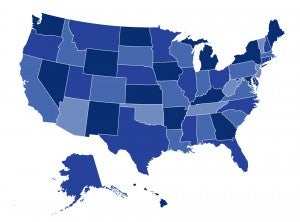
One thing all the political candidates seem to agree upon, regardless of party, is that health care costs too much. And of course they’re right. While health insurance premium increases have moderated somewhat during the last few years, the average cost of a family policy is over $15,000 per year. The United States spends over $8000 per capita on health care, more than twice as much as western European countries such as France, Sweden, and Great Britain. There’s also considerable consensus that the primary driver of health care cost increases is the amount we spend on the delivery of care – hospitals, doctors, pharmaceuticals, and the latest in medical gadgetry.
At the federal level, the Affordable Care Act (ACA) attempts to address these rising costs through a suite of policy changes in public programs like Medicare and Medicaid, such as encouraging the formation of accountable care organizations and patient-centered medical homes, reducing payments for hospital readmissions, and adopting value-based purchasing strategies. These initiatives are intended to re-align the way providers are reimbursed so that they focus on improving quality and efficiency.
The ACA also puts pressure on private sector insurers to play a role in quality improvement and cost containment efforts. The ACA calls on insurers to report on strategies to improve health care quality. In addition insurers offering plans through insurance exchanges will be required to implement quality improvement strategies like the initiatives described above. Last year a CHIR report analyzed a number of other ways the health insurance exchanges could encourage health plans to improve the quality and efficiency of health care delivery.
Quality improvement and cost containment efforts are gaining steam in the states, as well. At CHIR, as part of a Robert Wood Johnson Foundation 10-state initiative, we’ve been tracking the efforts of a few states to use their regulatory authority to help keep coverage more affordable for consumers. These states are using rate review to hold insurers accountable for some of the underlying drivers of premium increases and, in particular, the reimbursements insurers pay to health care providers.
For example, as we document in our recent report on rate review efforts in these ten states, Oregon and New York are exploring ways to use rate review to support each state’s delivery system reform efforts. In Oregon, the Insurance Division and the Oregon Health Authority (OHA) – which purchases insurance coverage for state employees, teachers, and Medicaid – are working together to encourage payers to implement delivery system reforms. State officials envision a multi-payer approach in which OHA will set goals for best practices for higher quality, more efficient care, and the Insurance Division will use its rate review authority to encourage insurance companies to incorporate those same best practices into their contracts with health care providers.
In New York, insurance regulators are in the initial stages of assessing how they can use rate review to support insurers’ efforts to “bend the medical cost curve” through the state’s multi-payer medical home pilot, as well as other delivery system reforms.
Rhode Island has moved forward the most rapidly, in part because the Office of the Health Insurance Commissioner (OHIC) has broad authority to address health care cost drivers through rate review. In 2010, the office released a set of “Affordability Standards” for insurers, under which their requests for premium rate increases will be assessed. These standards include efforts to improve the delivery of primary care, adopting a chronic care model of medical home, standardizing electronic medical records, and working towards comprehensive payment reform. The Rhode Island Commissioner has used his rate review authority to reduce rate increases fueled by overly high hospital reimbursements, noting, “We police the outliers and let the hospitals know we’re watching them.”
These insurance departments are working in tandem with other state officials to send a consistent, unified message to the insurers and providers in their state: as health care purchasers (through Medicaid and state public employees) and as regulators, they’re going to use every leverage point they can to encourage higher value coverage for their citizens.
Be sure to check in with CHIRblog where we’ll keep you updated on our research and everything you need to know about the “State of the States.”

